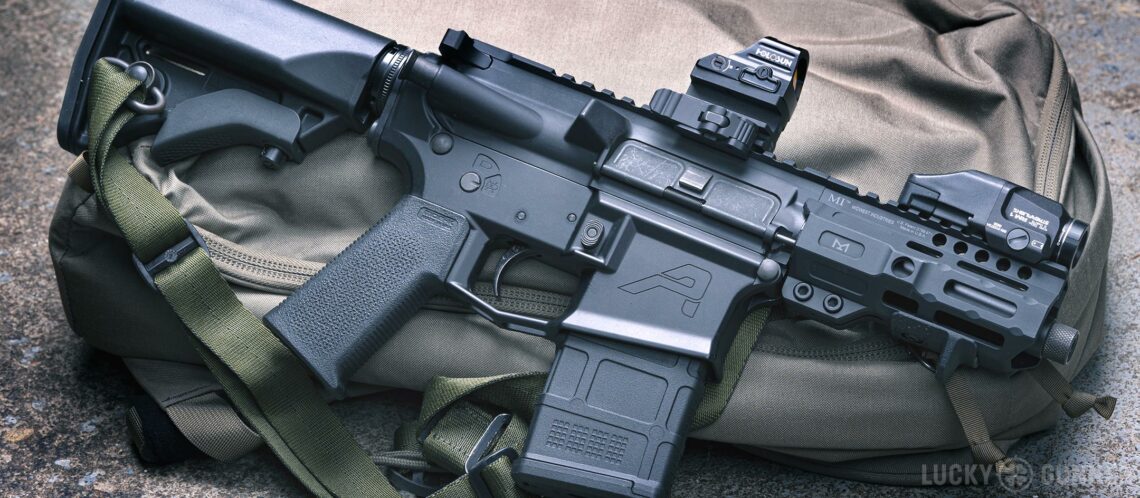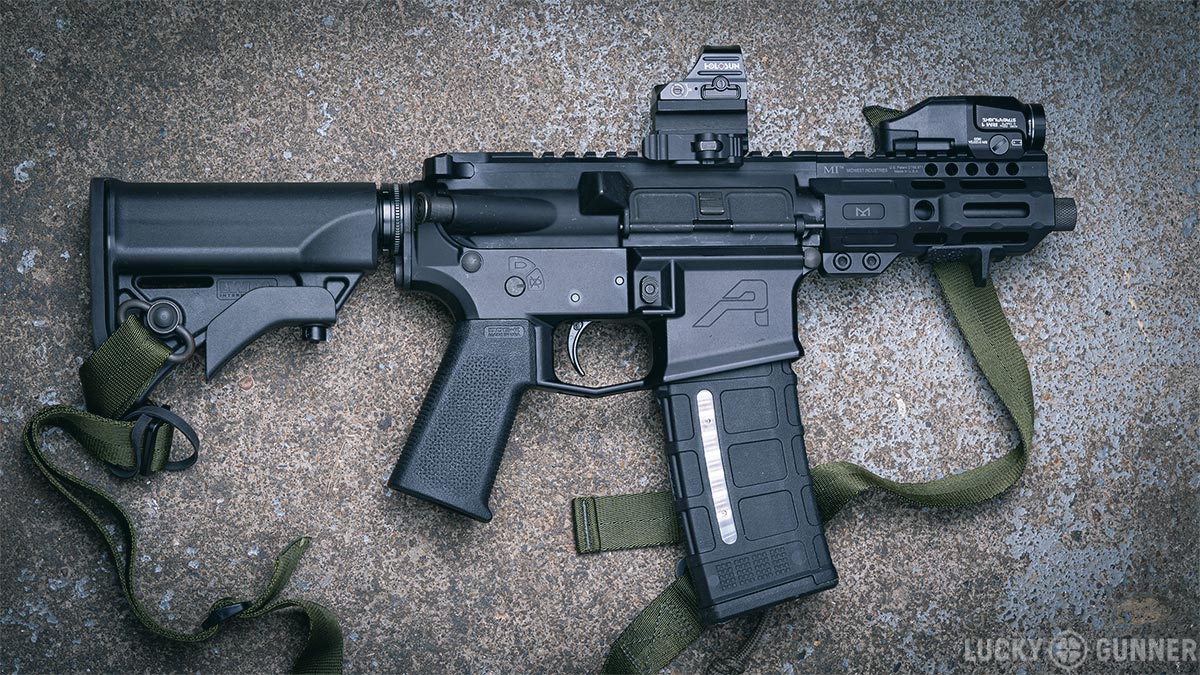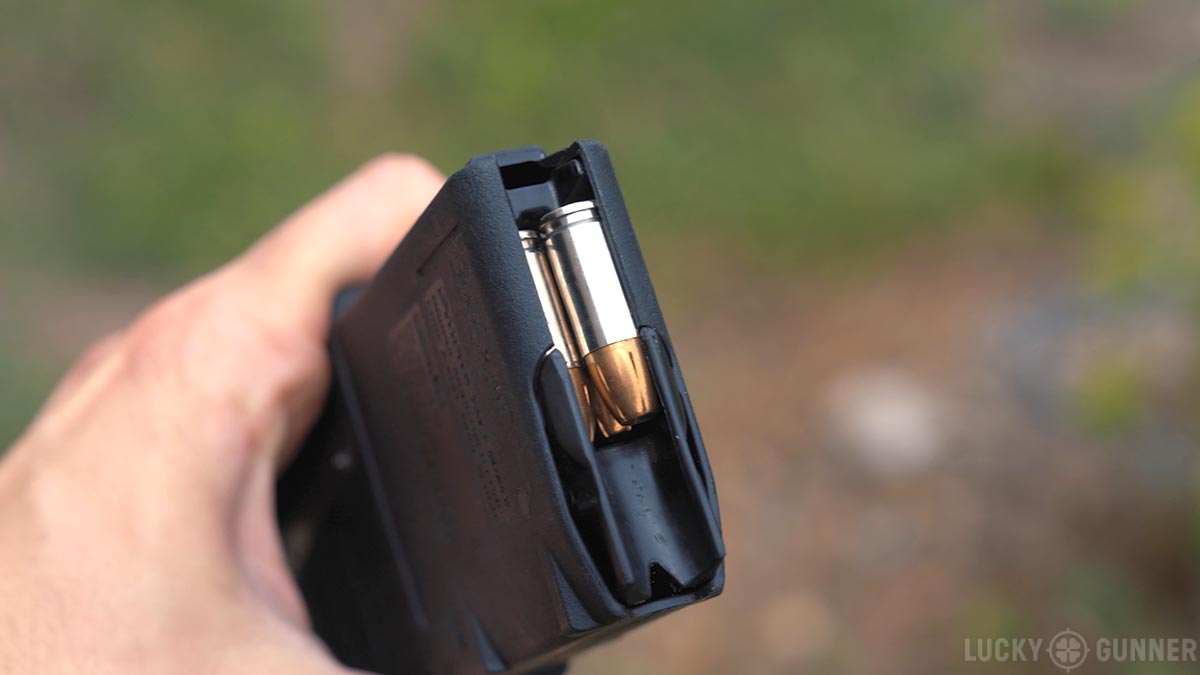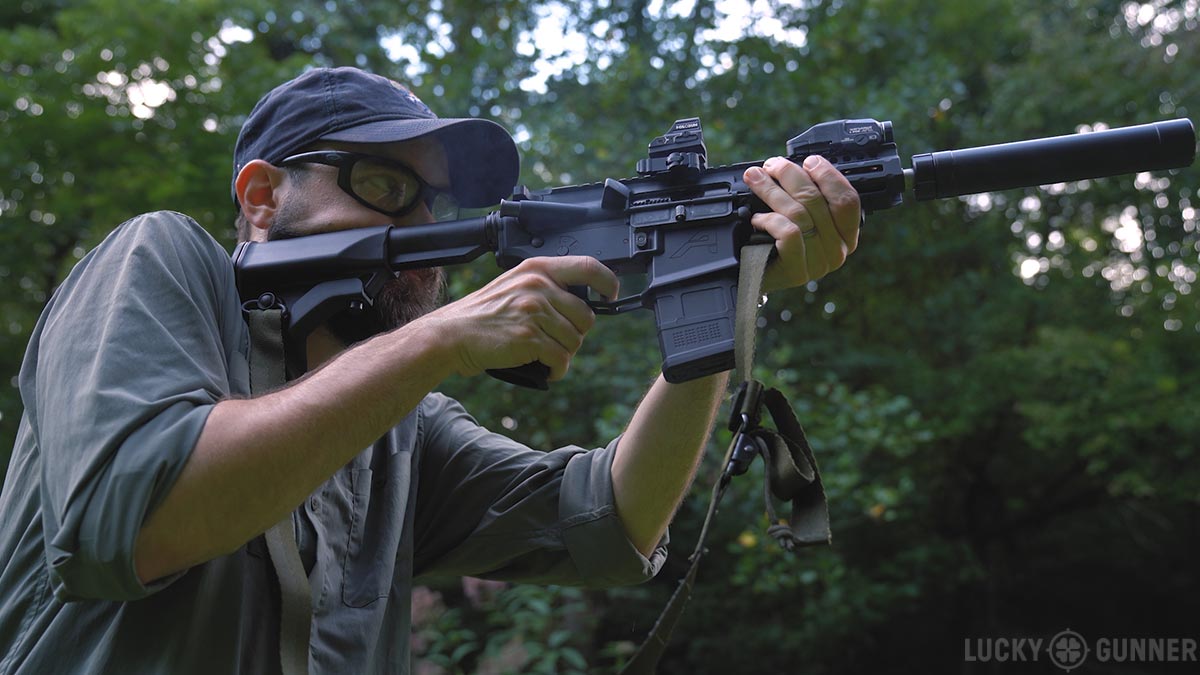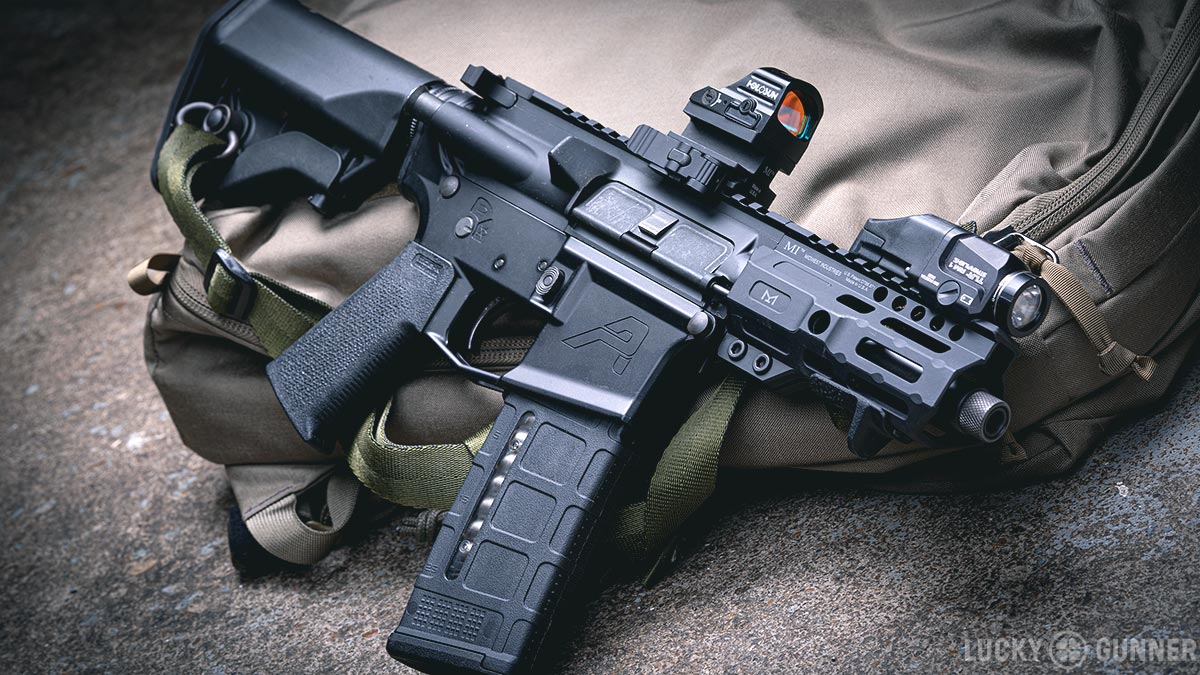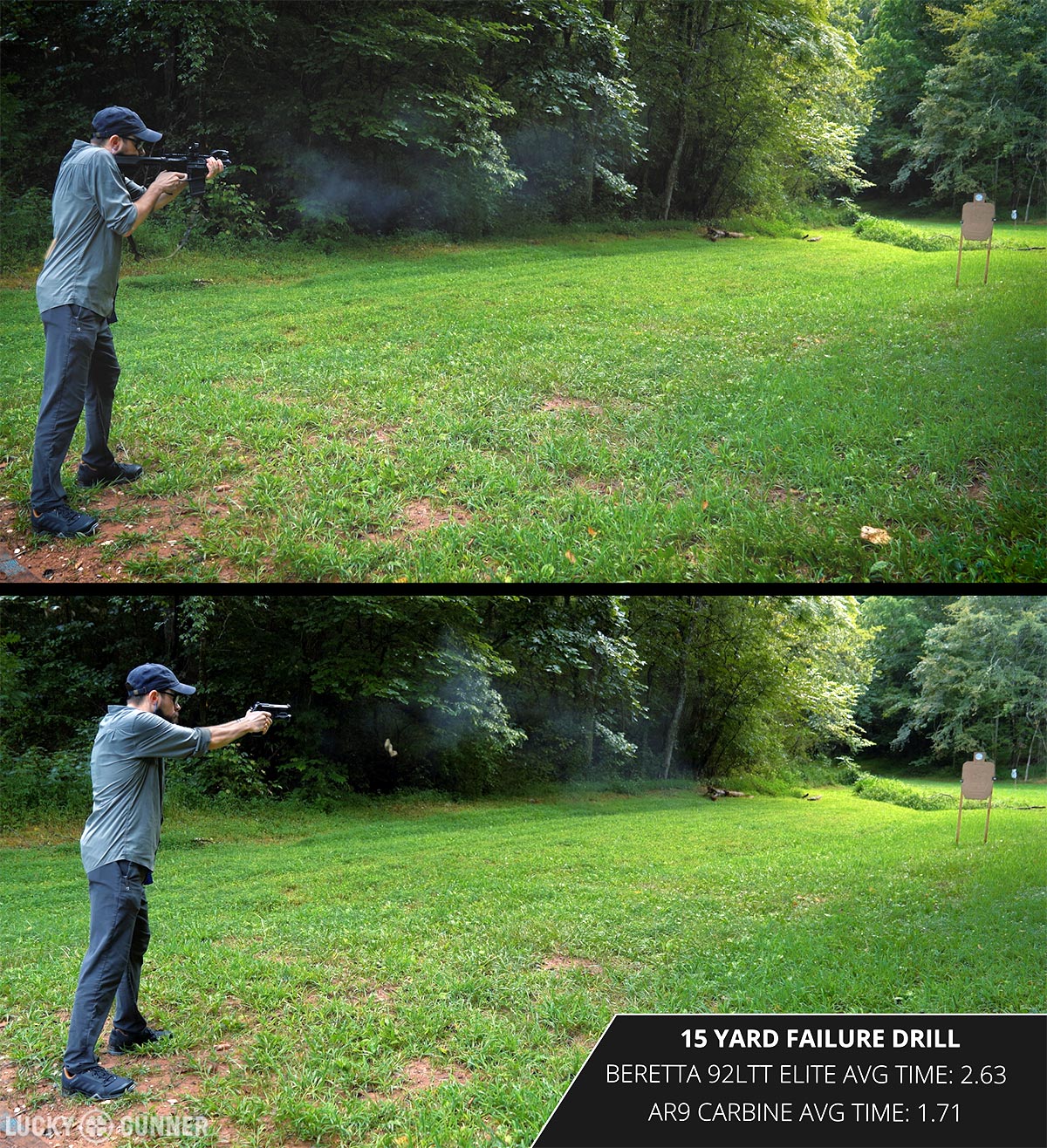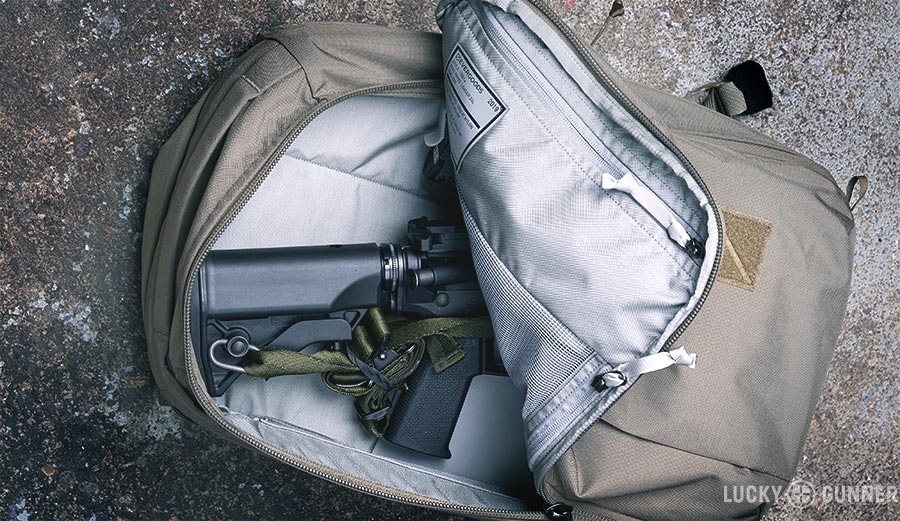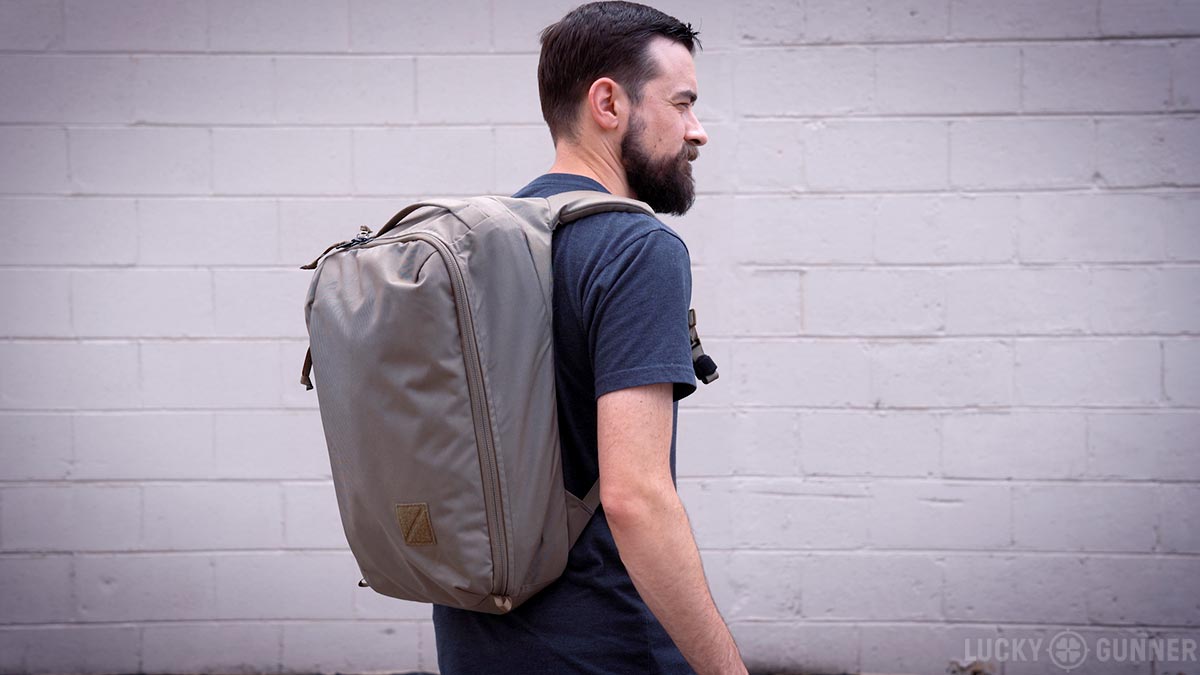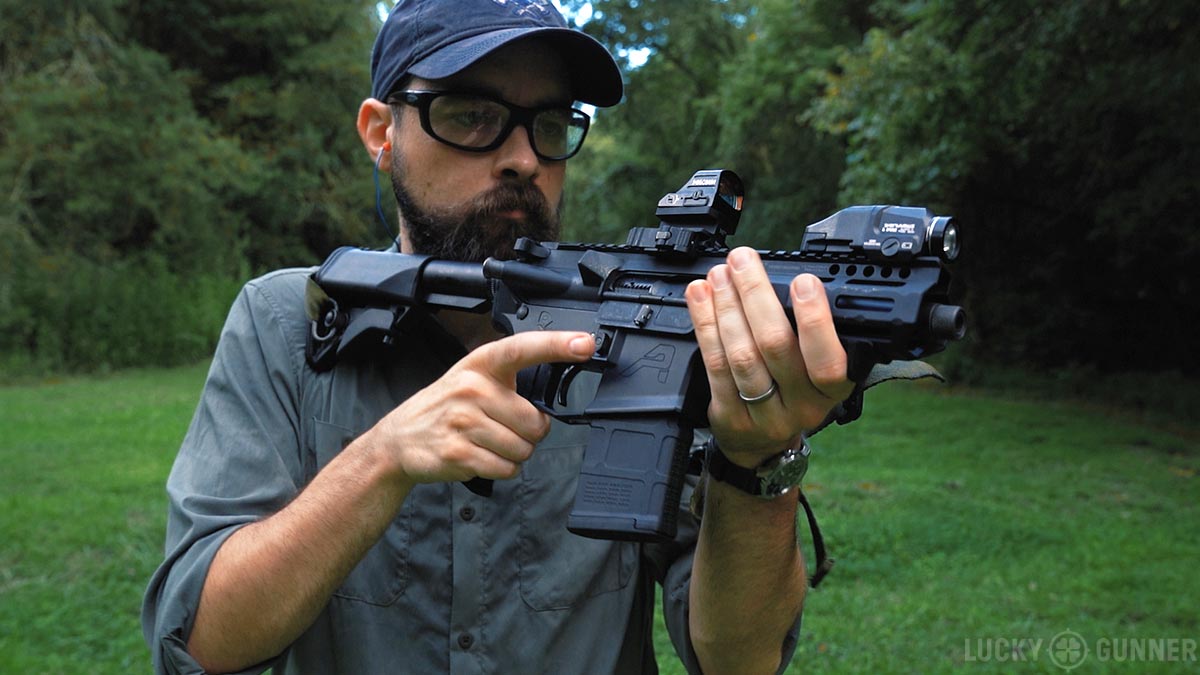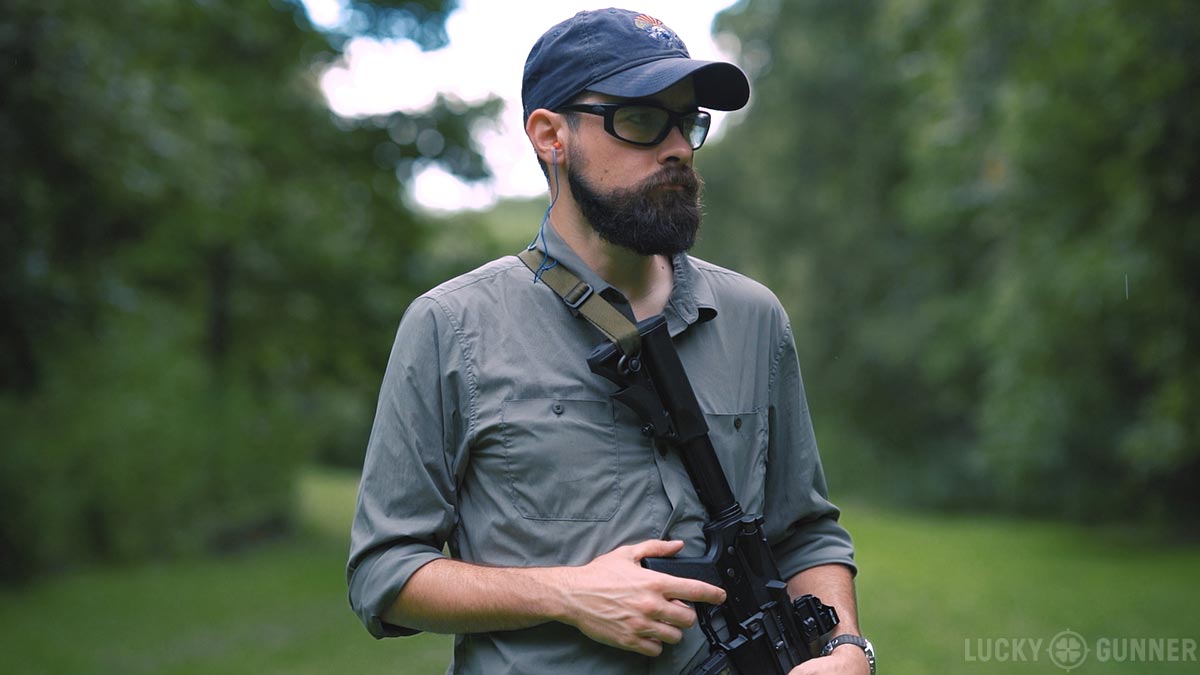Let’s talk about backpack guns! Everybody knows that putting tiny rifles in bags is cool. But realistically, under what circumstances could an Average Joe actually whip out a PDW and put it to use (without… you know, going to jail)? We’re diving into that topic today and also taking a detailed look at my personal backpack gun setup — an AR9 build carried in an Evergoods CPL 24.
Today’s video is a bit on the long side, so I’m providing timecode shortcuts below the embed if you’d like to skip around. Or if you’d prefer, as always, you can keep scrolling to read the full transcript.
Video Timecode Shortcuts
0:00 – Backpack gun defined
1:15 – Why?
4:45 – Alternate solutions for crowd violence
7:05 – When is a backpack gun useful?
8:11 – Hardware discussion – my personal criteria for a backpack gun
9:28 – Specs for my AR9
16:45 – AR9 versus handgun
19:12 – The backpack – Evergoods CPL 24
24:36 – DIY 20-round 9mm PMAG
25:44 – Staging and deploying a backpack gun
Backpack Gun Defined
Hey everybody, I am Chris Baker from LuckyGunner.com. Backpack guns have been a popular topic of discussion lately. And for today, I’m not talking about a gun you take with you on a backpacking trip. A backpack or bag gun is usually a PDW-type firearm small enough to fit in the kind of inconspicuous bag you might carry with you in public on a daily basis.
For those of us working in an office, it might be some kind of laptop bag. It could be a diaper bag, or a gym bag, or a briefcase — something that’s not going to look out of place for you in your everyday life.
The gun is often a short-barreled carbine or a large format pistol with a stabilizing brace. But it could also be a takedown rifle or even a stockless shotgun.
I’ve got my personal backpack gun setup that I’ve been working on here. I’ll show you guys the gun and the backpack itself in great detail in just a minute. First, I want to talk about some of the “why” behind the backpack gun. As the saying goes, “the mission drives the gear train.” It’s always fun to look at some cool gear, but there’s really not much point in it if we don’t know what it’s for.
Why?
Prior to this year, the idea of incorporating a long gun into your everyday carry was not really a mainstream concept in the shooting and self-defense world. A lot of us had certainly thought about it, but I don’t think many people were going to the trouble of actually doing it on a regular basis.
I know a lot of people have discreet bags or cases they use to transport their gun from one place to another without drawing attention. And I’ve seen some backpack guns that are used for pest control or hunting. But in this most recent wave where people have been sharing their bag gun setups on social media, the guns seem to be geared toward personal protection and everyday carry.
The Changing Landscape
So what’s changed? Why are backpack guns suddenly relevant? For me, there are two major factors that come to mind.
The first is innovation in the firearms market. Compact carbines and shotguns have been popular for a long time, but within the last few years, we’ve seen huge strides in those product categories. There are the folding stock adapters, the pistol stabilizing braces, a ton of new compact pistol caliber carbines, and new rifle loads and calibers that are optimized for short barrels. These new products have plenty of uses beyond backpack guns, but the fact that they are commonly available has opened the door for people to apply them to the role of everyday carry.
The second, and probably more important factor is that 2020 happened. Now, I don’t want to be an alarmist. I know the news media paints a pretty grim picture right now. But I think most of our cities are still generally very peaceful places to be 99.9% of the time. Here in Knoxville, for example, it’s not all doom and gloom. Nobody’s setting cars on fire and the kid at Chick-Fil-A still says “my pleasure” when I thank him for the chicken nuggets. At least for now.
But I think the events of this year have highlighted just how fragile that peace can be. It doesn’t take a whole lot of imagination to come up with a plausible future in which it might make sense to keep a long gun close at hand when you’re outside the home.
A Different Kind of Threat
Normally, the kind of serious violent threats we as law-abiding private citizens are most vulnerable to are crimes like armed robbery, home invasion, and sexual assault. Typically, that involves one to three attackers inside about 20 feet. If we don’t have any other option, a small handgun, a well-practiced drawstroke, and a willingness to act are usually enough to get us out of those situations.
Today, however, we’re hearing more about rioting, mob violence, potential acts of domestic terrorism, and a possible increase in violent crime as a result of inadequate law enforcement. What happens if you are being threatened by a large violent group of people who has targeted you for some arbitrary reason? Or what do you do if you find yourself stuck between two competing groups of rioters and they’re blocking the path between you and your vehicle? How about if a mob surrounds your office building and they start chucking rocks and Molotov cocktails through the windows?
Again, the likelihood of these scenarios is still pretty remote for most of us, but if that changes, it would be a good idea to have your options figured out ahead of time.
It’s Not All About the Gun
Now, I don’t want to imply that a long gun is always the best solution to any of these potential problems. In fact, as things stand now, it’s probably a very poor solution most of the time. As always, deadly force is an option of last resort. If I find myself in a situation where a carbine is coming out of my backpack, I have probably either not been paying attention or I have made some serious errors in judgement. That’s particularly the case with mob violence. Avoidance or escape are almost always better solutions.
I’m going to leave a couple of links to articles by Greg Ellifritz. Greg has done an excellent job of addressing the dynamics of crowd violence and how to recognize it before you’re stuck in the middle of it. Greg also has some good information on this topic in his new book Choose Adventure. These problems are not novel, they’re just novel to us as Americans who grew up after the 1960s. There are a lot of lessons to learn from people who have studied and survived mob violence in other countries and at other times where that kind of thing was more commonplace.
Legal Implications of Deploying a Backpack Gun
We also have to be aware that using deadly force in a crowd has some serious legal implications. I’ve got another link for you on that topic. It’s an excellent interview with Massad Ayoob that I highly recommend you read. He talks about the important distinction between rioters, a mob, and legitimate protestors. He also points out that some of the crowd-related violence that we’re seeing right now is often being perpetrated by a few bad actors who are using a crowd of peaceful protestors as a kind of camouflage. If you start blindly firing into a crowd like that, you are absolutely going to come out as the bad guy.
And really, in general, carrying a long gun in public is going to be perceived by most Americans as an inherently offensive, rather than defensive, act. A jury of 12 people who have never touched a gun before might be open to the idea that a person could carry a concealed handgun for legitimate self-defense. That’s at least something they’ve heard of before. Convincing them that you carry a rifle (or a “pistol” that very much resembles a rifle) purely for self-defense could be a serious uphill struggle in comparison.
When Could a Backpack Gun Be Useful?
So what does all of that mean as far as the mission of the backpack gun? I think it still has a role, it’s just a very narrow one. As far as I see it, a backpack gun might be a good tool under circumstances where:
- I’m outside the home. If I’m at home, I probably have access to a bigger gun.
- I’m in a place I can’t easily escape. Or I’m acting in defense of someone else who can’t escape — most likely a family member.
- I’m facing a credible deadly threat with enough advance warning to have time to retrieve the gun from the backpack
- I’m in a situation where being seen with a long gun is not going to automatically make me a target. That most likely means I’ve already been clearly targeted for violence and there’s no law enforcement around.
- It’s a situation where using a long gun would give me better odds of survival than my concealed handgun.
That’s not a comprehensive list, but if I can check all five of those boxes, my backpack gun might start looking like a good option. With all that in mind, let’s go back to the workshop area and take a look at some actual hardware.
Setting Up a Backpack Gun
Setting up a backpack gun has the same kind of challenges as figuring out your concealed carry hardware. There’s some gear that’s objectively bad and there’s some that’s objectively good. But every person’s situation is different and there’s no magic equipment that’s going to work well for everybody.
Priorities
For me, I decided the gun had to easily fit into the kind of unassuming bag that I might take to the office or to the park or anywhere else I might go on foot in the city or suburbs. I also wanted enough room in the bag for my laptop and other everyday stuff I like to have with me. So for the gun, that meant size and weight would be top priorities.
Budget was another concern. I didn’t want to pay much more than I would setting up a standard mid-grade AR-15. So around $1200 or less for the base gun before any optics or accessories.
I ruled out rifle calibers pretty early on. I’m really not interested in firing an unsuppressed short barreled rifle without hearing protection. Especially if it’s a gun I might end up firing inside my car. So I was mostly looking at pistol caliber carbines. And based on previous experience, I knew I wanted to avoid direct blowback guns if possible. That really helped narrow down the options pretty quickly.
5-Inch AR9 SBR Build
I eventually decided to assemble my own 9mm AR with a 5-inch barrel. It’s just under 19 inches long. Unloaded without any of the accessories, it weighs 4.4 pounds. Fully loaded with 30 rounds in this configuration, it comes in at 6.4 pounds. This is a registered NFA Short-Barreled Rifle.
CMMG Radial Delayed Blowback System
Some of you might remember seeing a version of this gun in the video I did a few weeks ago about SBRs versus pistol braces. This is basically a standard AR upper and lower receiver, but I’m using a CMMG Radial Delay Blowback bolt, barrel, and magazine conversion kit.
This is not something that was on my radar at all until I saw a video that Ian McCollum from Forgotten Weapons did on it. He did a great job of explaining how the radial delay blowback system works, so I won’t go into that. All you really need to know for now is that this is not a direct blowback design like most pistol caliber carbines. That means it shoots a lot softer and cleaner than a typical 9mm AR. You also don’t get all that gas blowing back in your face if you run it with a suppressor.
For this to work with a standard lower, CMMG partnered with Mean Arms to make these magazine kits that convert a 5.56 Magpul PMAG to feed 9mm. All you have to do is take out the original spring and follower and insert this adapter. You can also buy pre-assembled mags from CMMG if you don’t have any spare PMAGS laying around. In either case, there are no modifications required to the lower receiver itself. So I can still use this lower with a normal rifle caliber upper if I want to.
To me, that was a huge benefit because I already had this lower. If I decide I don’t like this configuration, I’m not stuck with a registered SBR lower that only works with a specific caliber or a non-standard magazine.
CMMG also offers the radial delay blowback system in a complete gun called the Banshee, formerly known as the Guard. Depending on the caliber, they’ve got versions with a standard AR lower like this one, or pistol-specific lowers that take Glock, Colt, or Sig P320 mags.
I was not really crazy about the way the Banshee was configured, and like I said, I already had this complete lower. So, I opted to buy just the CMMG bolt and barrel kit. The upper and lower I’m using are both from Aero Precision.
Handguard
The handguard is a Midwest Industries M-Lok compatible Combat Rail. There aren’t a whole lot of 4.5-inch handguards to choose from. I like this one because it has integrated sling attachment points. That’s a major asset on a small handguard that barely has enough room for a decent grip. It would be nice if it had an integrated hand stop like some of the other short handguards do. I’m using a Magpul handstop for now and that leaves just enough room for my hand in front of the mag well. I’m planning to try a couple of other handstops that can be mounted slightly farther forward.
Stock
The stock is from LWRCI. It’s actually a complete stock, buffer, and buffer tube kit they call the Ultra Compact Individual Weapon or UCIW Stock Kit. Fully collapsed, the stock only adds 5.75 inches. That’s about two inches less than most standard AR stocks.
There are a few PDW-style stock kits out there that will get the overall length even shorter. A lot of them look cooler and they all have better names than this one. But the LWRCI UCIW is a very simple and elegant solution. It doesn’t require a proprietary or modified bolt carrier group. It’s basically just a shorter version of the traditional 5-position stock and buffer tube that we all know and trust. Plus, at only 131 bucks, it’s one of the more affordable PDW stock kits on the market.
With the stock fully extended, you get a length of pull of about 12.5 inches. Again, about two inches shorter than a standard AR. And it does feel a little cramped to me. But I can get a good cheek weld with it. It’s a lot closer to the ergonomics of a full size rifle compared to most other compact stocks I’ve tried.
Grip
The grip I’m using also helps with the ergonomics. This is the Magpul MOE-K grip. It has a slightly more vertical grip angle that puts the hand in a better position when you’ve got a short length of pull. In particular, I’ve noticed that it makes the safety selector easier to manipulate on this gun.
Misc Parts
A few other little things for your hardcore gear nerds — I’m using a Geissele G2S trigger, a BCM Mod 4B charging handle, a PWS Ratchet Castle Nut and End Plate, and a VTAC Original 2-Point Sling. If you started from scratch, it would cost about $1100 to put together something like this, not including the optic, the mount, the light, and the tax stamp. I already had a lot of this stuff, so I was able to get it done way under my planned budget.
Optic
For the optic, I’ve got a Holosun HS507C V2 with a Midwest Industries quick detach mount. I chose an open reflex style sight mostly because they’re very small and light. The battery in this thing is supposed to last at least a year and probably a lot longer. Of course, we know it doesn’t always work out that way. There’s not a lot of room on this gun for backup iron sights, so I paid a little extra for the version of this optic that has the solar powered failsafe.
Weapon-Mounted Light
The white light here on the front is another thing I chose based mostly on size. This is a Streamlight TLR RM1. I tried three or four different lights I had laying around before I bought the RM1. The only real option for mounting a light on this handguard is at 12 o’clock. Anywhere else and there would not be enough space for getting a solid grip and I did not want to resort to using a vertical foregrip. So I needed a light that was low enough to not interfere with the optic.
I also needed a light with a switch that wasn’t going to get accidentally turned on inside the bag. That’s another issue I had with the other lights. This light doesn’t have any side switches. Just one switch in the back. It also has a lockout feature. If you twist the bezel, it puts the light into safe mode and the button won’t turn it on.
It’s not a super powerful light. It’s 500 lumens with a max candela of 5000. That’s probably good enough for positive target identification at close range, even if it’s not pointed directly at the target. That’s the main thing I normally want a light to do for me in a self-defense context. But the backpack gun context is a little different and I think I would prefer something much brighter, if possible.
In any case, there’s no such thing as a weapon mounted light that’s too bright. As soon as I can get a brighter light in a package similar to this one that costs less than a mortgage payment, I’ll probably upgrade.
Why Not Just Use a Pistol?
If there’s anything I’ve learned with this project it’s that a backpack gun is all about compromises. You can’t look at it like it’s a home defense or a general purpose carbine that happens to fit in a bag. It’s a PDW. It’s an upgrade from your concealed handgun.
I’ve got 30 rounds of 9mm here. I could easily equal that if I just carried a compact pistol and a spare magazine. But the main benefit I’m looking to get out of a backpack gun is not ammo capacity or even superior ballistics. A carbine just makes it a lot easier for me to put the bullets where I want them to go.
Of course, this is a really tiny carbine and it’s not quite as easy to run as a normal 16-inch AR. So I did some side by side comparison drills with a pistol to make sure there was still a significant improvement. The 9mm AR went up against the Beretta 92 LTT Elite because it’s the handgun I probably shoot best right now.
Just like everybody else, my supply of range ammo is looking pretty sad these days. So I chose a simple exercise with a low round count — the Failure Drill. Two to the body and one to the head at 7 yards. I started from low ready with both the pistol and the carbine.
With the Beretta, my average time after five runs was 1.64 seconds. With the carbine, it was 1.25 seconds. Then I repeated the drill at 15 yards. I averaged 2.63 seconds with the Beretta and 1.71 with the carbine.
I’ve talked about this a few times before, but it’s important to remember that the point of these drill comparisons is not to suggest that a gunfight is always decided by a couple of tenths of a second, or even a full second. In this case, the results on the timer and the target are a quantifiable way to demonstrate how much less effort it takes to run the carbine versus the handgun. I put at least ten times more practice into shooting handguns than carbines and rifles. I still always shoot a carbine much, much better. I’m more confident about what I can hit, and there are shots I can easily take with a carbine that I would never attempt in the real world with a handgun.
My little backpack gun does not have the ergonomics of a standard size carbine. Obviously, it lacks the range and power of a rifle caliber. But in terms of getting rounds on target, there’s no doubt that it’s a significant step up for me over a handgun.
The Backpack
The backpack itself is also a pretty important part of this equation. Did you guys know there is a whole online community of backpack and bag enthusiasts? I can’t say I’m surprised, but I was completely unaware of that world until I started this project. If you want a stitch by stitch review of just about any backpack on the market, there are whole blogs and YouTube channels devoted to that stuff. That is not my thing and I can’t do as thorough a job as those guys. But I did quite a bit of research and I looked at a lot of backpacks. I even tried out four or five of them for a couple of weeks each.
This is the one I keep coming back to. It’s the Evergoods Civic Panel Loader 24 or CPL 24. They’re just about to release their second version of this bag and you can get a really good deal on the original right now. My main criteria for a backpack were that it had to be the right size to fit a gun and all the rest of my stuff without looking conspicuously large. It had to generally have a discreet non-tactical appearance. And it needed to be sturdy enough to support the gun.
The CPL 24 pretty much fits all of those criteria, and it’s got a few other features I’ve come to appreciate. I like the way the pockets are laid out and how comfortable it is even with a lot of weight in it. I do wish it came in some less tactical-type colors. Even though they’re not at all trying to appeal to the shooting or tactical market, all their bags are either dark khaki or black. I still think it’s a fairly discreet-looking bag that doesn’t scream “gun” unless the person wearing it dresses like a wannabe military contractor.
There’s one small pocket on the outside here, the main compartment in the middle, and then a slim laptop pocket. The main compartment has two zipper pockets. The cool thing about these is that they have their own dedicated volume. That means when you cram them full of stuff, they don’t take up space in the main compartment. So no matter what I put in these pockets, I know the gun is still going to fit in here.
I prefer to carry the gun in the bag with the muzzle down because I don’t really like the muzzle staring me in the face when I open it up. But if you carry it that way, you’ve got 5 to 8 pounds of rifle that’s all concentrated on one spot where the muzzle contacts the bottom. That could wear a hole pretty quickly if the bag isn’t made to handle that kind of abuse. Or if it’s a lightweight material, you’re going to have an awkward bulge where the gun is sagging down on one side.
So ideally, your bag needs to have some kind of reinforcement at the bottom or it needs to be made from a material that’s thick and tough enough to handle that kind of pressure. The bottom of this bag is reinforced with multiple layers of material and it seems to support the weight of the gun really well.
That’s the main reason most of the backpacks I looked at belong to a category that a lot of people would consider “higher end products.” If you buy a cheap bag from a big box store, it’s probably not going to hold up as well. It’ll be made from weaker materials or the stitching will give out if you put any significant weight in the bag. Evergoods is just one of several companies that have been looking at the ruggedness and durability of the better outdoor and military-style backpacks and they’re applying those features to more everyday style backpacks that don’t look out of place in a coffee shop or an office. That’s a trend we can definitely take advantage of for a backpack gun.
I have made one small modification to this bag. I get really annoyed with dangling straps on backpacks. So I just roll them up and secure them with these little velcro cable ties. You can get fancy ones that are made for backpacks, but these cost $7 for 20 of them and they work just fine.
The specs on the Evergoods website say this bag is 18 inches tall. That’s actually a pretty conservative measurement. There’s enough room in here for something about 19 inches long. If you go diagonally corner to corner, there’s more like 19.5 inches of clearance. This is a fairly typical height for most of the medium-sized everyday carry type bags. If you’re under about six feet tall, you probably don’t want a bag that’s a whole lot taller than this or it might look somewhat awkward for everyday carry. For scale, I’m 5’9” and I think it fits me pretty well.
With the stock collapsed, this gun is 18.75 inches, and it fits in here at an angle pretty comfortably without any bulging. And I’ve still got a little room at the bottom for my medical kit. Behind this little divider pocket, I’ve got a 9-ounce can of bear spray, which is a much more useful crowd control tool if we have not crossed that threshold for deadly violence.
DIY 20-round 9mm PMAG Conversion
What would be really nice is if there was a version of this 9mm magazine adapter for the 20-round P-MAGS. A shorter 20-round mag makes it much easier to get the gun in and out of the bag. I don’t know if CMMG has any plans to make one of those. So I decided to give it a shot myself. What I came up with is this hideous monstrosity that’s basically a hacked up 30-round mag adapter that I melted back together with a soldering iron — but it works.
We don’t have enough spare ammo sitting around these days to do any extensive testing with it. So far, it’s fed about 200 rounds without any problems. I’m sure it won’t last as long as one of the original unaltered mag adapters. If I can make a crappy one that seems to work okay, I’m sure CMMG and Mean Arms can make a good one that works a lot better. Unless I’m the only weirdo who wants to see that happen, why don’t you guys let them know that the people have spoken and maybe that will become a reality.
Staging and Deploying a Backpack Gun
Really briefly, I want to talk about actually deploying this thing — how I stage it and I would go about getting it out of the bag and ready for use. First of all, I’m going to keep it in a cruiser ready condition. That’s with a loaded magazine, chamber empty, safety on. I never want to store a firearm with a round in the chamber if it doesn’t have the trigger fully covered and protected. Also, like most long guns, AR-15s are not drop safe. So an empty chamber is the way to go. If there’s not enough time to chamber a round, that’s what my handgun is for.
I’m pretty sure I’ve mentioned before that I’m not really adamant about slings on home defense carbines and shotguns. They have some uses, but they can also easily get in the way and snag on doorknobs. When you’re done with the gun, you can usually put it down or put it away. But outside the home, I think a sling is necessary. The sling is like a holster for your long gun. You’re probably not going to have a safe place to put the gun and you need to be able to use both hands without pointing the gun at people or abandoning it. It could also help prevent someone taking your gun away from you. I recommend a two-point sling over a single point sling because if you let go of the gun, it doesn’t just dangle freely with the muzzle pointed at your legs and feet.
The major downside of a sling on a backpack gun is that it tends to snag on the inside the bag if you don’t stage it properly. There are a dozen different ways to stow your sling. I’ve just got a plain rubber band on mine. I fold the sling a couple of times and secure it with the rubber band, leaving enough slack so I can still grip the gun. When I extend the stock, the sling might either come unfolded or stay the way I left it. Either way, it’s not going to interfere with firing the gun. When I have time to actually put it on, I can just give the sling a tug and it comes out of the rubber band.
Again, the backpack gun is not a great option if I need immediate access to a firearm. My concealed pistol will always be quicker. I’ll only go to the backpack if I’ve got some advance warning. However, I still want to be able to get it out as quickly as possible without a lot of fumbling around.
Want to See more?
Okay guys, that is the current state of my backpack gun setup. It’s probably going to change over time. This is all very experimental. I have tried out a couple of other guns in this role that are totally different from this one. Let me know if you want to hear more about those.
In the meantime, well… I would ask you to get some ammo from LuckyGunner.com but we don’t really have a whole lot right now. We’re working on it, though. We actually get multiple shipments every week, it just sells out really fast. Huge thanks to those of you who have shopped with us to support this content. We really appreciate it. If you’ve been trying to get ammo but can’t find the caliber you want, just be patient. It’s coming eventually. So in the meantime, subscribe if you haven’t already, and if you don’t mind, mash that like button for me.
